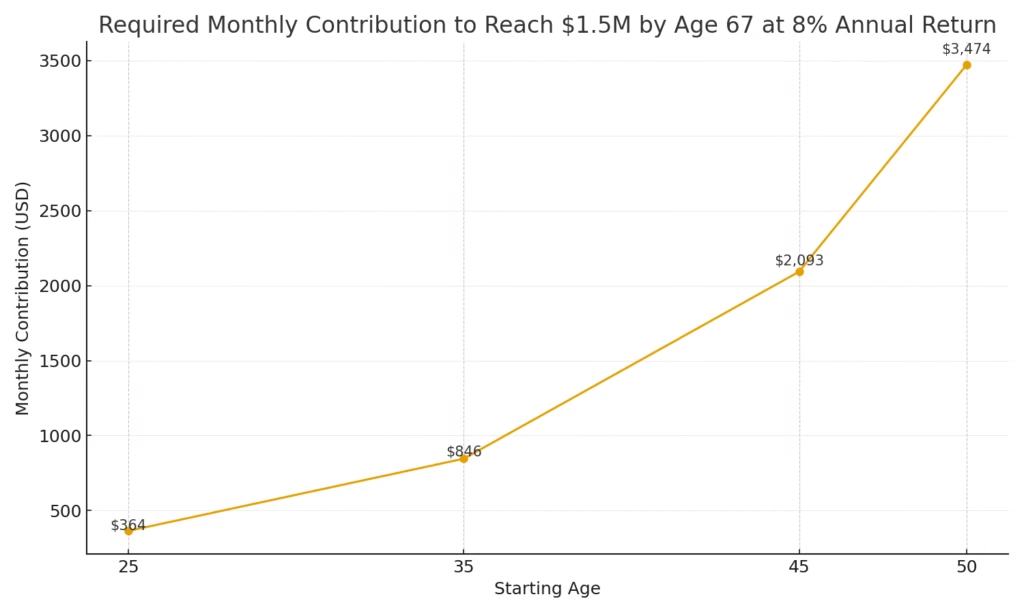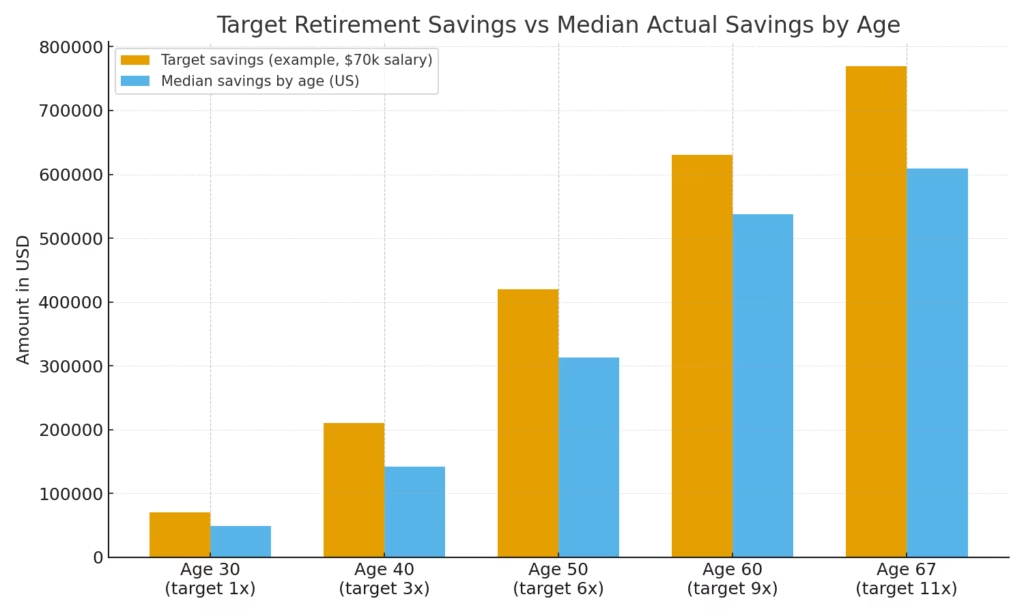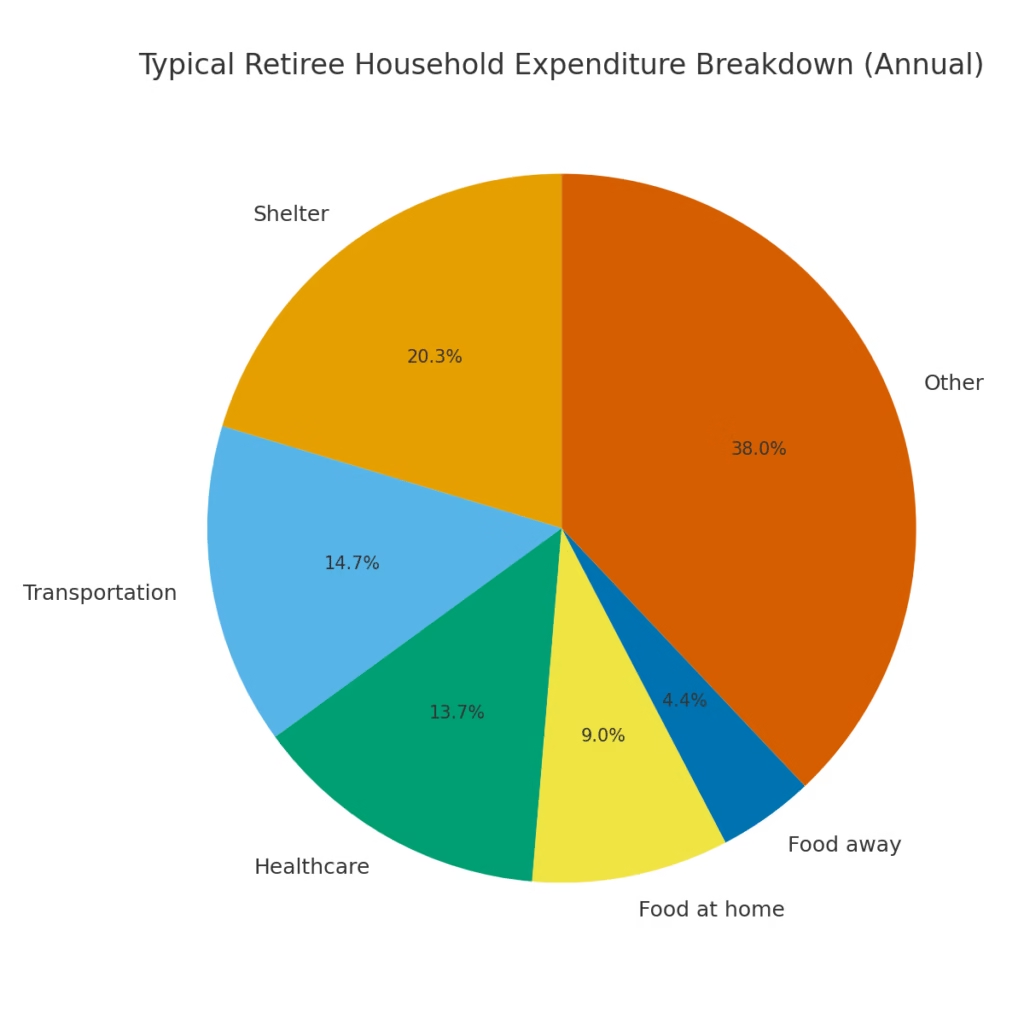
Retirement savings in USA is one of the most common financial concerns people face today. Whether you are in your 20s just starting your career, or in your 50s planning the final stretch before retirement, the big question remains the same: How Much to Save for Retirement in the USA to live comfortably?
This blog will break it down into simple, actionable insights. You’ll learn exactly how much money you may need to retire, strategies to save and invest, and real-world examples. By the end, you’ll have a clear roadmap for your retirement journey.
Why Retirement Savings in USA Matters
The cost of living in the US is rising steadily. According to the Bureau of Labor Statistics, an average retired household spends about $50,000 annually on housing, healthcare, food, and other expenses. With inflation averaging 3 percent annually, you can imagine how much more you will need in 20 or 30 years.
But retirement is not just about covering expenses. It’s about freedom. Freedom to travel, spend time with family, pursue hobbies, and enjoy life without financial stress. That’s why retirement savings in USA is not optional. It’s a must-have financial goal.
The Big Question: How Much to Save for Retirement?
A common rule of thumb is the 25x Rule. Simply put, you need 25 times your expected annual expenses to retire comfortably.
For example:
- If you plan to spend $50,000 per year, you’ll need $1.25 million saved.
- If you want $80,000 per year, you’ll need $2 million.
Another benchmark is the 80% Rule, which suggests you’ll need about 80 percent of your pre-retirement income to maintain your lifestyle.
Quick Quiz for You:
If you currently spend $60,000 annually, how much would you need to retire using the 25x Rule?
(Hint: $60,000 x 25 = $1.5 million).

How Retirement Savings Varies by Age
Let’s look at how much you should ideally save at different life stages.
- By age 30: At least 1x your annual salary.
- By age 40: 3x your salary.
- By age 50: 6x your salary.
- By age 60: 8-10x your salary.
- By retirement (67): 10-12x your salary.
For example, if you make $70,000 a year:
- At 30, you should have $70,000 saved.
- At 40, $210,000 saved.
- At 60, $700,000 saved.
This progressive saving method keeps you on track without feeling overwhelmed.

The Role of Investments in Retirement Savings
what is mutual fund and how to invest. Mutual funds are one of the most powerful tools for retirement planning.
- What is a mutual fund?
A mutual fund is a pool of money from many investors, managed by professionals, and invested in stocks, bonds, or other assets. - How to invest in mutual funds?
You can start with as little as $100. Choose funds that match your risk tolerance. For retirement, a mix of equity mutual funds (for growth) and bond mutual funds (for stability) works best.
Example:
If you invest $500 per month into a mutual fund with an average return of 8%, after 30 years you’ll have $745,000.
Quick Example of Retirement Math
Imagine you are 35 and want to retire at 65. You estimate you’ll need $1.5 million.
- If you save $1,000 per month in mutual funds at 8% return, you’ll reach it comfortably.
- If you wait until 45, you’ll need to save $2,300 per month for the same goal.
Lesson: The earlier you start, the easier it gets.
Tax-Advantaged Retirement Accounts in the USA
When thinking about retirement savings in USA, one of the smartest moves is to use tax-advantaged accounts. These accounts not only help you grow your savings but also reduce the tax burden, giving your money more room to compound.
401(k) Plans
A 401(k) is offered by many employers. You contribute pre-tax dollars, which lowers your taxable income today, and the money grows tax-deferred until retirement. Most companies also provide a matching contribution. Think of this as free money you should never leave on the table.
Example:
If you earn $70,000 per year and contribute 6 percent ($4,200), and your employer matches 3 percent ($2,100), you are instantly adding $6,300 into your retirement every year. Over 30 years at 7 percent growth, this can turn into nearly $600,000.
Roth IRA
Unlike the 401(k), a Roth IRA is funded with after-tax dollars. The benefit is that your money grows tax-free, and withdrawals in retirement are also tax-free. This is a great option for younger workers who are likely in a lower tax bracket now compared to what they may face later.
Contribution limits for 2026 allow up to $7,000 annually if you are under 50, and $8,000 if you are above 50.
Traditional IRA
Similar to a 401(k), contributions are tax-deductible, and growth is tax-deferred. However, contribution limits are lower than employer-sponsored plans. This account works well if you do not have access to a 401(k).
Using a Retirement Calculator
Numbers can sometimes feel abstract. This is where retirement calculators help. They factor in your current savings, monthly contributions, expected returns, inflation, and life expectancy.
For example, suppose you are 40 years old with $100,000 already saved. You invest $800 per month in a portfolio with 7 percent returns. By the time you reach 67, your nest egg could grow to nearly $1.1 million.
These calculators give you clarity on whether you are on track or if you need to adjust your savings rate.
Real Case Studies of US Families
Case 1: The Johnsons
The Johnson family earns $120,000 annually. They want to retire at 65 and expect to spend $70,000 per year. Following the 25x rule, they will need $1.75 million. With a 401(k), Roth IRA, and additional taxable investments, they are saving 20 percent of their income. Based on projections, they are expected to hit their retirement goal comfortably.
Case 2: Sarah, Single Professional
Sarah is 28 and earns $60,000. She has just started contributing $500 per month into a target-date mutual fund. If she stays consistent until age 67 at a 7 percent return, she will retire with approximately $1.2 million. This shows the power of starting early.
Case 3: Michael, Late Starter
Michael is 50 and has just $50,000 in savings. His goal is $1 million by 67. He must contribute at least $2,500 per month in a balanced mutual fund portfolio with an 8 percent return. Though it is aggressive, with discipline he can still make it.

Retirement Savings Benchmarks by Net Worth
Another way to check if you are on track is to compare your savings to national averages. According to Federal Reserve data:
- The median retirement savings for Americans aged 35-44 is about $60,000.
- For ages 45-54, the median is $115,000.
- For ages 55-64, it climbs to $200,000.
However, experts agree these numbers are far below what is truly needed. That is why aiming for 10-12 times your annual income by retirement age is a stronger benchmark.
Why Inflation is the Silent Killer of Retirement
It is easy to think that having $1 million is enough. But remember inflation. If inflation averages 3 percent annually, prices will nearly double in 24 years. What costs $50,000 today will require $100,000 in retirement.
That is why investments must outpace inflation. Mutual funds with equity exposure, along with a diversified portfolio, give your retirement savings the growth needed to stay ahead of rising costs.
Lifestyle Choices That Shape Retirement Savings in USA
One of the most overlooked aspects of retirement savings in USA is lifestyle. The amount you need will not only depend on your portfolio size but also how you plan to live after you stop working.
If you plan to travel frequently, own a vacation home, or dine out often, your retirement budget will be higher. On the other hand, if you live modestly, downsize your home, or relocate to a state with lower living costs, you can retire comfortably with a smaller nest egg.
A smart strategy is to create three lifestyle scenarios: essential expenses (housing, healthcare, food), moderate lifestyle (traveling occasionally, hobbies), and luxury lifestyle (frequent travel, second homes, premium healthcare). By assigning numbers to each, you can see what retirement budget you realistically need.
The Role of Healthcare in Retirement Planning
Healthcare is one of the largest expenses for retirees in the United States. According to Fidelity Investments, the average retired couple may need over $315,000 for healthcare costs throughout retirement, excluding long-term care.
Medicare provides coverage, but it does not cover everything. Prescription drugs, dental, vision, and assisted living can quickly add up. This is why some retirees invest in Health Savings Accounts (HSAs) during their working years. Contributions are tax-deductible, growth is tax-free, and withdrawals for medical expenses are also tax-free.
Pro tip: If you are under 65, maxing out your HSA contributions is one of the most efficient ways to prepare for retirement medical expenses.
Comparing Retirement Savings Globally
How does retirement savings in USA compare with other developed countries?
- In the UK, retirees rely heavily on workplace pensions and the State Pension.
- In Canada, the Canada Pension Plan (CPP) and Old Age Security (OAS) provide base income, but most still need private retirement accounts like RRSPs.
- In Singapore, the Central Provident Fund (CPF) requires mandatory contributions that ensure citizens have structured retirement savings.
- In Australia, the Superannuation system mandates employer contributions of 11 percent, helping workers accumulate significant retirement funds.
The US system is unique because it relies heavily on individual responsibility. Unlike some other countries, Social Security alone is often not enough, which is why consistent contributions to 401(k)s, IRAs, and other investments are critical.
Step-by-Step Guide to Retirement Planning
To make things simple, here is a five-step framework you can follow:
- Calculate your retirement number: Use the 25x rule by multiplying your annual retirement expenses by 25.
- Maximize tax-advantaged accounts: Contribute as much as possible to 401(k), IRA, or Roth IRA.
- Invest smartly: Choose low-cost mutual funds, ETFs, and dividend-paying mutual funds to balance growth and income.
- Plan for healthcare: Use HSAs and consider supplemental insurance.
- Review regularly: Revisit your plan every year to adjust contributions, rebalance your portfolio, and track progress.
For those who are also exploring investments, check out our blog Index Funds or Mutual Funds: Which is Better? for a detailed comparison of investing styles.
Quiz for You
Here is a quick question for you:
If you expect to spend $80,000 annually in retirement, how much would you need based on the 25x rule?
a) $1 million
b) $1.5 million
c) $2 million
Comment your answer in comment section, and I will share the solution.
(Hint: Multiply 80,000 by 25)
Final Thoughts
So, how much do you really need to retire comfortably in the US? The answer depends on your lifestyle, healthcare needs, and savings discipline. For most, aiming for 10 to 12 times annual income, or using the 25x rule, is a reliable benchmark.
The key is to start early, invest consistently, and make smart adjustments along the way. Retirement is not just about reaching a financial number but about achieving the lifestyle and security you desire.
Whether you are 25 and just beginning, or 55 and catching up, the best time to take control of your retirement savings in USA is today.



